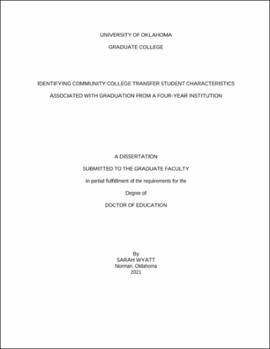| dc.contributor.advisor | Ford, Timothy | |
| dc.contributor.author | Wyatt, Sarah | |
| dc.date.accessioned | 2021-05-21T16:36:11Z | |
| dc.date.available | 2021-05-21T16:36:11Z | |
| dc.date.issued | 2021 | |
| dc.identifier.uri | https://hdl.handle.net/11244/329649 | |
| dc.description.abstract | Transfer students represent a rapidly growing subgroup in higher education. Increasingly, students are beginning their degree-seeking journeys at community colleges with the intention of transferring to a four-year institution. However, the number of students successfully transferring is much lower than the number of students that had goals to transfer upon matriculation to community college (Jenkins & Fink, 2015). Empirical evidence indicates a discontinuation in education after students depart community colleges. In effort to remedy this decline in transfer matriculation rates, both community colleges and four-year universities are developing supports to streamline the transfer process; however, to create strong supports for transfer students, institutions must first understand the barriers faced by the transfer student population. Despite this increase in community college enrollment, there is little literature to explain poor matriculation rates from community colleges to four-year institutions. To begin to address this gap in the literature, this study explored the characteristics among community college to four-year institution transfer students associated with graduation, using data from a sample of college students from a 2013 cohort from a community college system in Oklahoma. Findings reveal that community college students transferring to 4-year institutions were more likely to complete their bachelor’s degree in 6 years and more likely to have earned an associate’s degree while at community college. Furthermore, enrollment intensity, earning an associate’s in 3 years or less, and total semesters spent in higher education were are positively related to bachelor’s degree completion while enrollment intensity, semesters enrolled in community college, and enrollment in development education courses were are positively related to associate’s degree completion. Implications for policy and practice are discussed. | en_US |
| dc.language | en_US | en_US |
| dc.subject | Education, Higher Education Administration. | en_US |
| dc.subject | Community College | en_US |
| dc.subject | Transfer Students | en_US |
| dc.title | Identifying Community College Transfer Student Characteristics Associated with Graduation from a Four-Year Institution | en_US |
| dc.contributor.committeeMember | Ballard, Keith | |
| dc.contributor.committeeMember | Worley, Jody | |
| dc.contributor.committeeMember | Adams, Curt | |
| dc.date.manuscript | 2021 | |
| dc.thesis.degree | Ed.D. | en_US |
| ou.group | Jeannine Rainbolt College of Education::Department of Educational Leadership and Policy Studies | en_US |
| shareok.orcid | https://orcid.org/0000-0003-4091-0263 | en_US |
